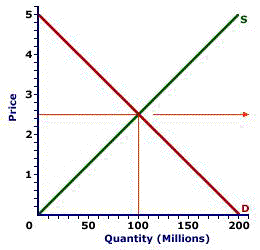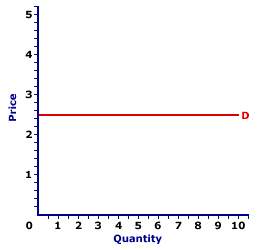
|
|
RIGID PRICES: The proposition that some prices adjust slowly in response to market shortages or surpluses. This condition is most important for macroeconomic activity in the short run and short-run aggregate market analysis. In particular, rigid (also termed inflexible or sticky) prices are a key reason underlying the positive slope of the short-run aggregate supply curve. Prices tend to be the most rigid in resource markets, especially labor markets, and the least rigid in financial markets, with product markets falling somewhere in between.
Visit the GLOSS*arama
|
|


|

|
                           PERFECT COMPETITION, DEMAND: The demand curve for the output produced by a perfectly competitive firm is perfectly elastic at the going market price. The firm can sell all of the output that it wants at this price because it is a relatively small part of the market. As a price taker, the firm has no ability to charge a higher price and no reason to charge a lower one. The market price facing a perfectly competitive firm is also average revenue and, most important, marginal revenue. A perfectly competitive industry is comprised of a large number of relatively small firms that sell identical products. Each perfectly competitive firm is so small relative to the size of the market that it has no market control, it has no ability to control the price. In other words, it can sell any quantity of output it wants at the going market price. This translates into a horizontal or perfectly elastic demand curve. It also translates in an equality between price, average revenue, and marginal revenue.Phil the Zucchini GrowerTake, for example, the production of zucchinis by Phil the gardener. While Phil the zucchini grower is not actually a perfectly competitive firm, because the real world does not contain any perfectly competitive firms that perfectly satisfy all of the characteristics of perfect competition, Phil does come close. He is one of gadzillions of zucchini growers. His zucchinis are identical to all other growers. He and others can easily enter and leave the zucchini growing business. And he has the same price and production technique information as other growers.In this case, the price that Phil charges and receives for his zucchinis is the going market price. There is nothing special about Phil's zucchinis that would let him charge a higher price, and there is no reason for him to charge less. As an extremely miniscule part of the zucchini market, Phil can sell every zucchini he produces at the going market price. He faces a perfectly elastic demand curve. Perfectly Elastic Demand| Demand Curve, Perfect Competition |  |  |
This exhibit illustrates the demand curve for the output produced by a perfectly competitive firm (that is, Phil and his zucchinis). The left side of the graph illustrates the overall zucchini market, in particular, the supply offer by millions of zucchini growers and the demand of millions of buyers. The equilibrium price achieved in the zucchini market is $2.50 and the equilibrium quantity is 100 million zucchinis.The right side of this graph illustrates the demand for Phil's zucchinis. Note that even though both sides of this exhibit look to be about the same size, the quantity axes have different measurement units. Whereas the quantity for Phil's zucchinis is in zucchinis, the quantity for the overall zucchini market is in millions of zucchinis. The key for Phil is that he can produce any quantity of zucchinis that he wants at $2.50, the going market price. Given millions of zucchini buyers, someone is willing and able to buy 5 to 10 zucchinis from Phil at $2.50 each. That makes the horizontal line emerging from the $2.50 price, the demand curve for Phil's zucchinis. Marginal and Average Revenue, TooThis demand curve is also the average revenue curve and the marginal revenue curve facing Phil for selling his zucchinis. Average revenue is the per unit revenue received for selling zucchinis. If Phil sells 10 zucchinis for $2.50 each, his total revenue is $25. His per zucchini revenue for these 10 zucchinis is then $2.50, which is also the price.Marginal revenue is the extra revenue received for selling one more zucchini. In Phil's case, each additional zucchini sold generates exactly $2.50 of extra revenue. Phil's marginal revenue is also $2.50 for every zucchini sold. This point might seem so incredibly obvious that there is really no reason to even mention it. However, a number of industries that do NOT meet the ideal characteristics of perfect competition (which is most firms populating the real world economy), do not have perfectly elastic demand curves and their marginal revenue is not equal to average revenue or price. A perfectly elastic demand curve and the equality of price, average revenue, and marginal revenue is what makes perfect competition important to study as a benchmark against which real world market structures can be compared.

Recommended Citation:PERFECT COMPETITION, DEMAND, AmosWEB Encyclonomic WEB*pedia, http://www.AmosWEB.com, AmosWEB LLC, 2000-2025. [Accessed: July 18, 2025].
Check Out These Related Terms... | | | | | | | |
Or For A Little Background... | | | | | | | | | | | |
And For Further Study... | | | | | | |
Related Websites (Will Open in New Window)... | | | |
Search Again?
Back to the WEB*pedia
|



|

|
BEIGE MUNDORTLE
[What's This?]
Today, you are likely to spend a great deal of time strolling around a discount warehouse buying club hoping to buy either a case for your designer sunglasses or arch supports for your shoes. Be on the lookout for crowded shopping malls.
Your Complete Scope
This isn't me! What am I?
|

|
|
A lump of pure gold the size of a matchbox can be flattened into a sheet the size of a tennis court!
|

|
|
"A winner is someone who recognizes his God-given talents, works his tail off to develop them into skills, and uses those skills to accomplish his goals. " -- Larry Bird, basketball player
|

|
OTS
Office of Thrift Supervision
|

|
|
Tell us what you think about AmosWEB. Like what you see? Have suggestions for improvements? Let us know. Click the User Feedback link.
User Feedback
|


|


